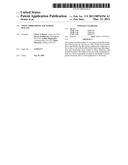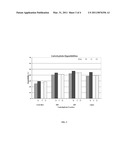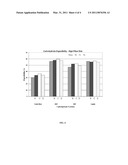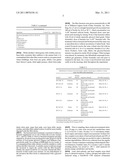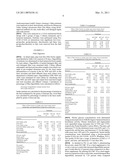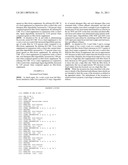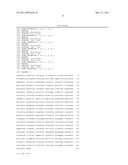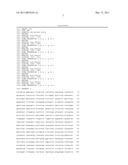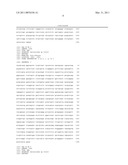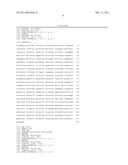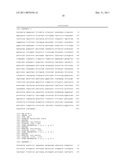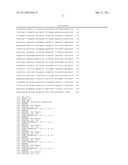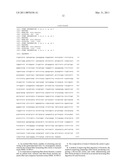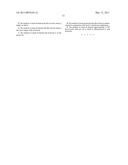Patent application title: Novel Fibro-Biotic Bacterium Isolate
Inventors:
Cherie J. Ziemer (Ames, IA, US)
Steven Arcidiacono (Bellingham, MA, US)
Arthur Ragauskas (Lawrenceville, GA, US)
Mark Morrison (Dublin, OH, US)
IPC8 Class: AA23K116FI
USPC Class:
426 2
Class name: Food or edible material: processes, compositions, and products treatment of live animal
Publication date: 2011-03-31
Patent application number: 20110076356
Claims:
1. An isolated fibro-biotic capable of colonizing and surviving in the
gastrointestinal tract of a monogastric animal, wherein the isolated
fiber fermenting fibro-biotic is bacterial strain NRRL B-50315.
2. A composition comprising fibro-biotic bacteria, a carrier and an animal feed, wherein said fibro-biotic bacteria ferments fiber and comprises bacterial isolate NRRL B-50315.
3. The composition of claim 2 wherein the carrier is glycerol.
4. A method of improving fiber digestion of livestock, the method comprising: preparing a fibro-biotic producing comprising a Bacteroides strain; and orally administering said fibro-biotic product to livestock in an amount increasing fiber digestion for said livestock.
5. The method of claim 4 wherein the Bacteroides strain is NRRL B-50315.
6. The method of claim 4 wherein the fibro-biotic reduces the fecal output of the livestock.
7. The method of claim 4 wherein the livestock is of the genus Sus.
8. The method of claim 4 wherein the fibro-biotic is administered in conjunction with food or nutritional supplement.
9. The method of claim 5 wherein approximately 1.times.10.sup.9 Bacteroides cells per ml of broth is administered to said livestock.
Description:
FIELD OF INVENTION
[0001]The present invention relates to an isolated anaerobic bacterium Bacteroides sp. for use as a fibro-biotic for livestock. More specifically, the fibro-biotic supplements a fiber diet of Sus scrofa scrofa, livestock improving fiber digestion and decreasing fecal output. The present invention also relates to the use of the isolated bacterium as a food composition to improve the health of monogastric livestock and as a feed supplement to livestock.
BACKGROUND OF INVENTION
[0002]The simplest digestive system consists of the mouth, associated glands, esophagus, stomach, small intestine, large intestine, pancreas and liver. This is the type of monogastric gastrointestinal tract is found in the pigs, dogs, mink, fish, monkeys, and humans. A monogastric tract has limited capacity for fiber digestion because of the lack of microbial action at the beginning of the digestive tract as compared to mammals with rumens.
[0003]In the United States, there has been high cost related to using corn as livestock feed inasmuch as a portion of corn has been utilized towards ethanol production. As such, there has been an increasing emphasis on substituting a high-fiber cereal feed for corn-based feed for monogastric livestock. However, fiber in the form of non-starch polysaccharides, include cellulose, beta-glucans and arabinoxylans, generally reduces the nutritional value of cereal livestock feeds and is generally considered undesirable as a monogastric livestock feed. When cereals such as wheat and barley are utilized, enzymes can be added to livestock feed to promote digestion of the non-starch polysaccharides. For instance, as disclosed in Emiola et al., 2009, J. Anim Sci., 87:2315-2322 Sus scrofa scrofa that were feed a diet of wheat distillers dried grains with solubles supplemented with a multi-carbohydrase mixture (2,600 units xylanase, 1,200 units glucanase and 1,300 units cellulose per kg feed or 5,200 units xylanase, 2,400 units glucanase and 2,600 units cellulose) exhibited improved growth performance and total tract digestibility than those without the enzymatic supplement.
[0004]Pertaining to Sus scrofa scrofa, various diet supplementations have been implemented to confer desirable livestock traits such and increased weight gain or increasing lean-to-fat ration of livestock. To with, U.S. Pat. No. 5,192,804 discloses a feed composition of L-carnitine in an admixture fed to starter Sus scrofa scrofa livestock that increases the lean-to-feed ratio for said Sus scrofa scrofa.
[0005]In another example, U.S. Pat. No. 5,077,068 discloses a liquid feed supplement of dry feed grain coated with vegetable fats and aromatic flavoring agents for monogastric animals.
[0006]Given the animal feed supplements in the field and an increased emphasis in using high-fiber cereal as a livestock feed source, there is a need to develop a feed supplement increases digestion of fiber material represented by plant cell structures such as lignin, hemicellulose, and cellulose in monogastric livestock. By doing so, the monogastric livestock would be able to more readily able to harness energy from fibrous cereals. Additionally, such a feed supplement would aid in reducing fecal output, thus reducing fecal management and environmental impact costs.
[0007]Given the need to utilize high fiber feeds and the limitation of monogastric system there is a need in the art to increase the nutritional value of cereal livestock feeds while maintaining a fiber diet for monogastric livestock.
BRIEF SUMMARY OF THE INVENTION
[0008]Disclosed is an isolated fibro-biotic capable of colonizing and surviving in the gastrointestinal tract of a monogastric animal, wherein the isolate fiber fermenting fibro-biotic is a bacterial strain NRRL B-50315. Also disclosed is a composition comprising a fibro-biotic bacterium, a carrier, and an animal feed, wherein said fibro-biotic bacterium ferments fiber and comprises bacterial isolate NRRL B-50315.
[0009]Also disclosed is a method of improving fiber digestion of livestock, the method comprising: preparing a fibro-biotic comprising a live Bacteroides strain; and orally administering said fibro-biotic product to livestock in an amount increasing in vivo fiber digestion. In one embodiment of the invention, the Bacteroides strain is NRRL B-50315. In another embodiment of the invention, the fibro-biotic reduces the fecal output of the livestock. In yet another embodiment of the invention, the livestock is of the genus Sus. A further embodiment of the invention is that the fibro-biotic is administered in conjunction with food or nutritional supplement.
BRIEF DESCRIPTION OF THE DRAWINGS
[0010]The present invention together with the above and other objects and advantages may best be understood from the following detailed description of the embodiment of the invention illustrated in the drawings, wherein:
[0011]FIG. 1 is a graph of average fecal output of Sus scrofa scrofa fed either a control fiber diet, high fiber diet, or with both diets combined. For each diet, Sus scrofa scrofa were given either no bacterial feed supplement (indicated as "none"), a feed supplement of Bacteroides strain SD CMC 3f (indicated as "B"), a feed supplement of Bacteroides strain RF Cell 1b2 (indicated as "C"), or a feed supplement of Bacteroides strain SD CC 2a (indicated as "D").
[0012]FIG. 2 is a graph of average carbohydrate digestibility percentage of crude fiber, neutral detergent fiber (hemicellulose+cellulose+lignin content), acid detergent fiber (cellulose+lignin content), and lignin content for Sus scrofa scrofa on a control diet feed diet. In addition to the control feed diet, Sus scrofa scrofa were given either no bacterial feed supplement (indicated as "none"), a feed supplement of Bacteroides strain SD CMC 3f (indicated as "B"), a feed supplement of Bacteroides strain RF Cell 1b2 (indicated as "C"), or a feed supplement of Bacteroides strain SD CC 2a (indicated as "D").
[0013]FIG. 3 is a graph of average carbohydrate digestibility percentage of crude fiber, neutral detergent fiber (hemicellulose+cellulose+lignin content), acid detergent fiber (cellulose+lignin content), and lignin content for Sus scrofa scrofa with both diets combined. In addition to the combined feed diet, Sus scrofa scrofa were given either no bacterial feed supplement (indicated as "none"), a feed supplement of Bacteroides strain SD CMC 3f (indicated as "B"), a feed supplement of Bacteroides strain RF Cell 1b2 (indicated as "C"), or a feed supplement of Bacteroides strain SD CC 2a (indicated as "D").
[0014]FIG. 4 is a graph of average carbohydrate digestibility percentage of crude fiber, neutral detergent fiber (hemicellulose+cellulose+lignin content), acid detergent fiber (cellulose+lignin content), and lignin content for Sus scrofa scrofa on a high fiber feed diet. In addition to the high fiber feed diet, Sus scrofa scrofa were given either no bacterial feed supplement (indicated as "none"), a feed supplement of Bacteroides strain SD CMC 3f (indicated as "B"), a feed supplement of Bacteroides strain RF Cell 1b2 (indicated as "C"), or a feed supplement of Bacteroides strain SD CC 2a (indicated as "D").
DEPOSIT OF BIOLOGICAL MATERIAL
[0015]Isolate SD CMC 3f, identified as a strain of Bacteroides ovatus str 4140 based on 16S rRNA gene sequencing. Sequence of SD CMC 3f was 97% similar to the sequences of Bacteroides ovatus strains with the following NCBI Accession numbers: AY895197, DQ100446, AY895193, EU722734, and AY652736. Isolate SD CMC 3f was deposited on Sep. 10, 2009, under the provisions of the Budapest Treaty in the Agricultural Research Culture Collection (NRRL) in Peoria, Ill., and has been assigned Accession No. NRRL B-50315.
DETAILED DESCRIPTION OF THE INVENTION
Definitions
[0016]As used in the specification and claims, the singular form "a", "an" and "the" include plural references unless the context clearly dictates otherwise. For example, the term "a bacterium" includes a plurality of unicellular microorganisms of the same species.
[0017]As used herein, "monogastric" is intended to encompass any animal having one stomach. Examples of monogastric animals include, but are not limited to, horses, emu, ostrich, dog, cat, swine, bear, turkey, chickens, ducks, quail, pheasants, reptiles, and humans. Pre-ruminant animals such as young cattle, buffalo, bison, and elk are also encompassed by the term monogastric as these animals are born monogastric and then develop into true ruminants as adults. In a preferred embodiment of the invention, the fibro-biotic is administered to livestock that are fed a fiber diet.
[0018]As used herein the term fiber refers to the soluble and insoluble components of feed that are not digested by enzymes in the livestock gastrointestinal tract. The primary sources of fiber include such cell wall materials as cellulose, hemicelluloses, lignin, and pectins, along with gums and mucilages from plant material.
[0019]The term "crude fiber" is defined as loss on ignition of dried residue remaining after digestion of sample with 1.25 percent sulfuric acid and 1.25 percent sodium hydroxide under specific conditions. Typical conditions and methods are described in the Official Method of Analysis of the Association of Official Analytical Chemists. The undissolved residue is rinsed with dilute sulfuric acid, deionized water, and ethanol, then reduced to ash. The crude fiber value includes the amount of cellulose and some indigestible lignins but does not distinguish between digestible and indigestible fiber.
[0020]"Neutral detergent fiber" and "acid detergent fiber" as used herein are analyses that involve the solubilization of non-fiber components of the feed in boiling detergent solution, with the residual material described as neutral detergent fiber or acid detergent fiber depending on the solution used. Neutral detergent fiber (NDF) analysis and acid detergent fiber (ADF) analysis originally described by P. J. Van Soest (Agricultural Handbook No. 379 entitled Forage Fiber Analyses (Apparatus, Reagents, Procedures, and Some Applications); pages 1-20; by H. K. Goering and P. J. Van Soest; Agricultural Research Service of the United States Department of Agriculture) is incorporated herein by reference. Typically, acid detergent fiber is measured by boiling the sample in an acid detergent solution. The mash is filtered. The residue contains wall fiber, primarily cellulose, lignin and silica. Neutral detergent fiber is typically measured by boiling the sample in a neutral detergent solution. The wash is filtered. The residue contains all of the structural plant parts, including cellulose, hemicellulose, and lignin.
[0021]As used herein the term "fibro-biotic" refers to live bacteria when fed to a livestock, increases fiber digestion for said livestock.
[0022]As used herein the term "isolated bacterium strain" means that the strain might be cultivated in vitro in a culture comprising said strain.
[0023]As used herein the term "suitable nutrient medium" means a medium, such as LAB broth, MRS broth, or Wilkens-Calgren broth in which bacteria might be cultivated.
Bacterial Strain Selection
[0024]Initially, 122 bacteria isolates from human excrement was provided from Natick Soldier Center (Natick, Mass.). The 122 isolates were initially sequenced for approximately half of a 16S rRNA gene allowing for grouping by sequence similarity. The isolates were then characterized by api Anaerobe Identification system (bioMerieux, Inc., Lombard, Ill.) and BBL Crystal Anaerobe Identification system (BD Diagnostics, Eden Prairie, Minn.) for their ability to grow on cellulose and xylan. Six bacterial strains (isolates SD CMC 3f, RF Cell 1b2, SD CC 2c, SD CC 1c, SD CC 1b, and RF Cell 1b1) were capable of growing on cellulose or xylan and were identified as Bacteroides ovatus strains. More particularly, strains SD CMC 3f, RF Cell 1b2, SD CC 1c, and SD CC 1b grew on cellulose and SD CC 2c and RF Cell 1b1 grew on xylan. Bacterial strain SD CC2a was characterized as a Bacteroides xylanisolvens strain and also grew on cellulose.
[0025]To determine the effectiveness of the six selected bacterial stains, forty-eight female PIC (Pig Improvement Corporation, Lexington, Ky.) grower Sus scrofa scrofa livestock were used to establish the effects feeding fiber utilizing bacteria with standard and high fiber diets. Treatments were arranged as a 2×4 factorial with 2 diets and 4 bacterial treatments. Sus scrofa scrofa (having an initial average body weight of 61.1 kg) were randomly assigned to experimental treatments and housed in two rooms with individual pens at the Iowa State University Swine Nutrition Farm. The Sus scrofa scrofa were fed diet compositions presented in Table 1 and consisted of control (3331 Kcal/kg metabolizable energy, 14% crude protein, 6.3% hemicellulose and 2.7% cellulose) and high fiber (3300 Kcal/kg metabolizable energy, 14% crude protein, 10.4% hemicellulose and 7.7% cellulose). The livestock were fed ad libitum and had free access to water and were adapted to the pens and diets for a period of seven days. All procedures involving animal handling and testing were reviewed and approved by the Iowa State University Committee on Animal Care (approval #9-06-6207-S).
TABLE-US-00001 TABLE 1 Diet formulations Ingredient Control (%) High Fiber (%) Corn 80.90 59.89 Soybean meal 16.69 5.37 Distiller's dried grains with solubles 20.00 Soybean hulls 10.00 Vegetable oil 2.3 CaCO3 0.74 0.97 Dicalcium phosphate (20% Ca 18.5% P) 0.93 0.35 Salt 0.35 0.35 Vitamin mix 0.25 0.25 Trace mineral mix 0.05 0.50 Selenium premix 0.05 0.50 L-Lysine-HCL 0.04 0.33 L-Threonine 0.05 L-Tryptophan 0.03
[0026]While distiller's dried grains with solubles and soybean hulls constitute fiber addition to the animal feed, it is contemplated that other fiber sources such as corn germ meal, wheat middlings, bran from any grain, alfalfa, corn gluten feed, brewer's grain, dried apple pomace, dried citrus pulp, dried citrus peel, sugar beet pulp, soya bean hulls, pectin residue, and other fiber-added sources would be more readily digested with the fibro-biotic.
[0027]The bacterial feed treatments consisted of either no bacteria supplement (A) or one of three Bacteroides isolates (B, C, and D) (Table 2). Prior to bacterial treatment and after adaptation, livestock were acclimated to take 20 ml of a 50:50 mixture of food grade glycerol (Sigma) and Wilkens-Chalgren broth orally via a syringe at 0900 daily for two weeks. It is contemplated that other carriers would be suitable to orally deliver the fibro-bacterial. A suitable carrier would encourage the livestock to ingest the carrier with the fibro-bacteria. Ideally, the carrier would be of a viscosity wherein the fibro-bacteria would confer even mixture. In one embodiment of the invention the fibro-biotic is administered with a glycerol carrier.
[0028]The fibro-bacteria were grown anaerobically in 100 ml of Wilkens-Calgren broth (Fisher Scientific, Inc, Pittsburg, Pa.) (1 ml of overnight bacterial growth inoculated into 100 ml of broth) for 24 h at 38° C. (final concentration was 1×109 bacterial cells/ml broth). Bacterial doses were prepared each morning by mixing 10 ml of the bacterial culture with 10 ml of sterile anaerobic glycerol (feed grade, Fisher Scientific), dose of bacteria was 1×1010 bacterial cells. The treatment with no bacteria had broth processed the same way as described above without inoculation of initial broth. Thus control livestock receive the same volume dose but with no bacterial cells in it. In a Coy anaerobic chamber (Coy Laboratory Products, Grass Lake, Mich.) the glycerol-bacteria mixture was placed in sterile 20 ml syringes. Filled syringes were placed, by treatment, into Mitsubishi anaeropak boxes, without gas generator, (Fisher Scientific) and seal prior to transport to the farm. Sus scrofa scrofa livestock were dosed orally at in the morning, daily throughout the experiment.
TABLE-US-00002 TABLE 2 Identification of human bacterial isolates capable of growing on cellulose or xylan using 16S rRNA gene sequencing Percent Isolatea CHOb Identityc Sequence Identity 16S rRNA sequence SD CMC 3f Cellulose 97 Bacteroides ovatus str SEQ. ID. No. 1 4140 RF Cell 1b2 Cellulose 98 Bacteroides ovatus str SEQ. ID. No. 2 4140 or 3941 SD CC 2c Xylan 99 Bacteroides sp Smarlab SEQ. ID. No. 3 3301643 or Bacteroides sp Smarlab 3302993 SD CC 1c Cellulose 99 Bacteroides sp Smarlab SEQ. ID. No. 4 3301643 or Bacteroides sp Smarlab 3302993 SD CC1b Cellulose 98 Bacteroides SEQ. ID. No. 5 xylanisolvens (NCBI accession no. AM230650) RF Cell 1b1 Xylan 97 Bacteroides ovatus str SEQ. ID. No. 6 3941 SD CC 2a Cellulose 98 Bacteroides SEQ. ID. No. 7 xylanisolvens (NCBI accession no. AM230650) aLaboratory isolate identifier. bCarbohydrate that the strain was originally isolated on. cData obtained using Mega-BLAST program (NCBI)
[0029]Prior to sampling, three weeks post treatment initiation; 24 pigs at a time were moved into metabolism crates (1.2×2.4 m) for 11 days. On days 7 to 11 total dietary intake, fecal output, and urinary output were measured. On these five days samples were taken of feed and feed refusals and 10% of the fecal output of each pig was pooled in order to determine nutrient digestibilities. Blood was collected from the jugular vein into vacuum containers containing sodium heparin (Becton Dickinson, Franklin Lakes, N.J.) on days 1 and 11 and the resulting plasma was stored at -20° C. until analyzed for plasma energy metabolites and insulin.
[0030]Feed, feed refusals, and fecal samples were dried prior to chemical analysis. Carbon, nitrogen and sulfur were analyzed using a VarioMAX CNS analyzer (Elementar Analysensysteme GmbH, Hanau, Germany). Other nutrients were analyzed on feed, feed refusals, and feces by Minnesota Valley Testing Laboratories (New Ulm, Minn.) using AOAC approved methods for ash, crude fiber, acid detergent lignin and crude protein.
[0031]Data were analyzed as a 2×2×4 randomized block design with 2 groups of pigs, 2 dietary treatments and 4 bacterial treatments. Statistics were performed using Proc GLM of SAS; no interactions were significant (two-way-group×diet, group×bacteria, diet×bacteria and three way, group×diet×bacteria) so they were removed from the final model.
EXAMPLE 1
Fiber Digestion
[0032]As detail supra, pigs were fed a fibro-biotic supplement detailed in Table 2 for a period of 36 days. Digestibility of nutrients was determined on feed and pooled fecal sample for each subject. Digestibility of neutral detergent fiber and acid detergent fiber were examined daily. Culture effluent subsamples and feed and inoculum samples were dried overnight in pre-weighed aluminum pans for dry fecal matter determination as is known in the art. NDF and ADF on the feed, inoculum and dried effluents from each culture were determined as detailed supra. Digestibilities (DM, NDF and ADF) were estimated for each culture by calculating total DM, NDF and ADF input and output from total feed weight and total inoculum and effluent volumes. Calculations of percentage of fiber digestibility were calculated as follows:
Percentage of digestibility=[(intake nutrient-fecal fiber)/intake fiber]×100
Intake nutrient was calculated as the percentage of nutrient in the feed multiplied by the grams of feed per day. Fecal fiber was calculated by percentage of nutrient in the feces multiplied by grams of feces per day.
TABLE-US-00003 TABLE 3 Effect of fibro-biotics on intake, gain, fecal output, blood metabolites, and digestibilities in pigs fed a control diet. Treatment SD CMC RF Cell SD CC None 3f 1b2 2a Measure Feed intake, g/day 2569.72 2510.95 2432.05 2613.00 Gain, kg/d 0.81 0.86 0.74 0.96 Fecal output, g/day 710.68 510.97 538.07 626.43 Fecal Dry Matter output, g/day 430.67 381.01 396.23 412.05 Gain/intake 0.33 0.34 0.30 0.38 Feces/intake 0.20 0.22 0.24 Blood metabolites Glucose, mg/dL 68.83 72.86 68.26 68.21 Insulin, μg/dL 0.15 0.09 0.20 0.1 Triglycerides, mg/dL 17.40 21.18 19.34 19.05 Cholesterol, mg/dL 66.06 79.85 78.09 76.53 Digestibility, % Dry matter 82.61 84.01 82.37 83.76 Crude protein 81.68 82.55 81.03 82.42 Crude fiber 19.78 23.91 16.63 22.66 Neutral detergent fiber 23.48 30.77 23.40 27.91 Acid detergent fiber 37.94 41.32 34.63 39.04 Starch 99.68 99.33 99.50 99.54 Lignin 23.44 35.87 22.88 23.28 Carbon 81.50 82.87 81.09 82.66 Nitrogen 78.64 79.08 77.88 79.61 Sulfer 69.40 70.70 69.75 70.55
TABLE-US-00004 TABLE 4 Effect of fibro-biotics on intake, gain, fecal output, blood metabolites, and digestibilities in pigs fed a high fiber diet. Treatment SD CMC RF Cell SD CC None 3f 1b2 2a Measure Feed intake, g/day 2488.89 2454.73 2670.83 2744.69 Gain, kg/d 0.86 0.89 0.86 0.86 Fecal output, g/day 852.67 722.17 979.90 969.75 Fecal Dry Matter output, g/day 472.13 449.23 488.58 572.72 Gain/intake 0.34 0.36 0.32 0.32 Feces/intake 0.34 0.29 0.36 0.35 Blood metabolites Glucose, mg/dL 68.98 72.03 73.97 70.74 Insulin, μg/dL 0.14 0.11 0.10 0.11 Triglycerides, mg/dL 28.77 25.51 24.65 26.29 Cholesterol, mg/dL 94.61 98.67 85.84 83.29 Digestibility, % Dry matter 79.27 79.73 80.09 79.50 Crude protein 74.80 76.55 76.37 76.20 Crude fiber 30.19 33.75 36.23 33.90 Neutral detergent fiber 56.14 57.90 59.90 57.40 Acid detergent fiber 46.99 52.07 52.37 48.83 Starch 99.42 99.52 99.45 99.55 Lignin 56.32 55.27 56.93 54.64 Carbon 78.40 78.96 79.27 78.65 Nitrogen 74.81 76.40 80.14 75.79 Sulfer 75.36 76.61 76.64 75.33
[0033]Plasma glucose concentrations were determined using an enzymatic kit (GAHK20, Sigma Chemical) based on hexokinase activity. Plasma cholesterol and triglycerides were quantified using enzymatic kits (C7510 and T7531, respectively, Pointe Scientific, Canton, Mich.). The intra- and interassay CV for the cholesterol assay were 0.8% and 1.1%, respectively, and the intra- and interassay CV for the triglyceride assay were 1.0% and 2.9%, respectively. Serum insulin concentrations were determined using a porcine-specific insulin ELISA kit (10-1129-01, ALPCO, Windham, N.H.). The insulin ELISA has a range of detection of 0.02 to 1.5 ng/mL and intra- and interassay CV less than 10%.
[0034]As detailed in FIG. 2, and Table 3, administering Bacteroides strain SD CMC 3f as a feed supplement to Sus scrofa scrofa on a control diet increased digestibility percentage of crude fiber by 4.3 percent when compared to no fibro-biotic supplement. By utilizing SD CMC 3f as a feed supplement in conjunction with a control diet, neutral detergent fiber digestibility increased by 7.29 percent when compared against no fibro-biotic supplement. By utilizing SD CMC 3f as a feed supplement in conjunction with a control diet, acid detergent fiber digestibility increased by 3.38 percent when compared against no fibro-biotic supplement. By utilizing SD CMC 3f as a feed supplement in conjunction with a control diet, lignin digestibility increased by 12.43 percent when compared against no fibro-biotic supplement.
[0035]As detailed in FIG. 4, and Table 4, administering Bacteroides strain SD CMC 3f as a feed supplement to Sus scrofa scrofa on a control diet increased digestibility percentage of crude fiber by 3.56 percent when compared to no fibro-biotic supplement. By utilizing SD CMC 3f as a feed supplement in conjunction with a control diet, neutral detergent fiber digestibility increased by 1.76 percent when compared against no fibro-biotic supplement. By utilizing SD CMC 3f as a feed supplement in conjunction with a control diet, acid detergent fiber digestibility increased by 5.08 percent when compared against no fibro-biotic supplement. By utilizing SD CMC 3f as a feed supplement in conjunction with a control diet, surprisingly lignin digestibility decreased by 1.05 percent when compared against no fibro-biotic supplement.
EXAMPLE 2
Decreased Fecal Output
[0036]As detail supra, Sus scrofa scrofa were fed fibro-biotics detailed in Table 2 for a period of 11 days. Digestibility of neutral detergent fiber and acid detergent fiber were examined daily. Culture effluent subsamples and feed and inoculum samples were dried overnight in pre-weighed aluminum pans for dry fecal matter determination as is known in the art. NDF and ADF on the feed, inoculum and dried effluents from each culture were determined using analytic methods listed supra. Digestibilities (DM, NDF and ADF) were estimated for each culture by calculating total DM, NDF and ADF input and output from total feed weight and total inoculum and effluent volumes.
[0037]As detailed in FIG. 1 and Table 3 and 4, average fecal output of Sus scrofa scrofa on a control diet supplemented with fibro-biotic B had a decrease in 199.71 grams of daily fecal output compared to those fed only a control diet. With the fibro-biotic B supplement, this was an approximate 39% decrease in daily fecal output when the livestock was on a control diet. Similarly, the average fecal output of Sus scrofa scrofa on a high fiber diet supplemented with fibro-biotic B had a decrease in 130.5 grams of daily fecal output compared to those fed only a high fiber diet. With the fibro-biotic B supplement, this was an approximate 18% decrease in daily fecal output when the livestock was on a high fiber diet.
[0038]While the invention has been described with reference to details of the illustrated embodiment, these details are not intended to limit the scope of the invention as defined in the appended claims. The embodiment of the invention in which exclusive property or privilege is claimed is defined as follows:
Sequence CWU
1
711336DNABacteroides ovatusmisc_feature(6)..(6)n is a, c, g, or t
1ggtgangaca cgngtcctnc ctgccgataa ctccgggaga ncctttcgaa agaannanna
60ataccggatg gtttaggaag accgcatggg agttttagta nggaatttcg gttatcgatg
120gggangcgtt ccnttagttt gttggcgggg taacggccca ccaagactac gatggatagg
180ggttctgaga ggaaggtccc ccacattgga actgagacac ggtccaaact cctacgggag
240gcagcagtga ggaatattgg tcaatggncg agagcctgaa ccagccaagt agcgtgaagg
300atganngctc tatgggtcgt aaacttcttt tatatgggaa taaagtattc cacgtgtgga
360attttgtatg taccatatga ataaggatcg gctaactccg tgccagcagc cgcggtaata
420cggaggatcc gagcgttatc cggatttatt gggtttaaag ggagcgtagg tggattgtta
480agtcagttgt gaaagtttgc ggctcaaccg taaaattgca gttgaaactg gcagtcttga
540gtacagtaga ggtgggcgga attcgtggtg tagcggtgaa atgcttagat atcacgaaga
600actccgattg cgaaggcagc tcactagact gtcactgaca ctgatgctcg aaagtgtggg
660tatcaaacag gattagatac cctggtagtc cacacagtaa acgatgaata ctcgctgttt
720gcgatataca gtaagcggcc aagcgaaagc attaagtatt ccacctgggg agtacgccgg
780caacggtgaa actcaaagga attgacgggg gcnccgcaca agcggaggaa catgtggttt
840taattcgatg atacgcgagg aanccttacc cgggcttaaa ttgcaacaga atanattgga
900aacagtatag ccgcaaggca attgtgaagg tgctgcatgg ttgtcgtcag ctcgtgccgt
960gaggtgtcgg cttaagtgcc ataacgagcg caacccttat ctttagttac taacaggtca
1020tgctgaggac tctagagaga ctgccgtcgt aagatgtgag gaaggtgggg atgacgtcaa
1080atcagcacgg cccttacgtc cggggctaca cacgtgttac aatggggggt acagaaggcg
1140gctacctggt gacaggatgc taatcccaaa aacctctctc agttcggatc gaagtctgca
1200acccgacttc gtgaagctgg attcgctagt aatcgcgcat cagccatggc gcggtgaata
1260cgttcccggg ccttgtacac accgcccgtc aagccatgaa agccgggggt acctgaagta
1320cgtaaccgca aggagc
133621396DNABacteroides ovatusmisc_feature(137)..(137)n is a, c, g, or t
2atgcagtcga ggggcagcat tttagtttgc ttgcaaactg aagatggcga ccggcgcacg
60ggtgagtaac acgtatccaa cctgccgata actccgggat agcctttcga aagaaagatt
120aataccggat ggcatantaa tatcgcatga tatttttatt aaagaatttc ggttatcgat
180ggggatgcgt tccattagtt tgttggcggg gtaacggccc accaagacaa cgatggatag
240gggttctgag aggaaggtcc cccacattgg aactgagaca cggtccaaac tcanacggga
300ggcagcagtg aggaatattg gtcaatggac gagagcctga accagccaag tagcgtgaag
360gatgaatgct ctatgggtcg taaacttctt ttatnatggg aataaagtat tccacgtgtg
420gaattttgta tgtaccatat gaataaggat cggctaactc cgtgccagca gccgcggtaa
480tacggaggat ccgagcgtta tccggattta ttgggtttaa agggagcgta ggtggattgt
540taagtcagtt gtgaaagttt gcggctcaac cgtaaaattg cagttgaaac tggcagtctt
600gagtacagta gaggtgggcg gaattcgtgg tgtagcggtg aaatgcttag atatcacgaa
660gaactccgat tgcgaaggca gctcactaga ctgtcactga cactgatgct cgaaagtgtg
720ggtatcaaac aggattagat accctggtag tccacacagt aaacgatgaa tactcgctgt
780ttgcgatata cagtaagcgg ccaagcgaaa gcattaagta ttccacctgg ggagtacgcc
840ggcaacggtg aaactcaaag gaattgacgg gggcccgcac aagcggagga acatgtggtt
900taattcgatg atacgcgagg aanccttacc cgggcttaaa ttgcannnga atannntgga
960aacagtatag ccgnaaggcn aatgtgaagg tgctgcatgg ttgtcgtcag ctcgtgccgt
1020gaggtgtcgg cttaagtgcc ataacgagcg caacccttat ctttagttac taacaggtca
1080tgctgaggac tctagagaga ctgccgtcgt aagatgtgag gaaggtgggg atgacgtcaa
1140atcagcacgg cccttacgtc cggggctaca cacgtgttac aatggggggt acagaaggca
1200gctacctggc gacaggatgc taatcccaaa aacctctctc agttcggatc gaagtctgca
1260acccgacttc gtgaagctgg attcgctagt aatcgcgcat cagccatggc gcggtgaata
1320cgttcccggg ccttgtacac accgcccgtc aagccatgaa agccgggggt acctgaagta
1380cgtaaccgca aggagc
139631395DNABacteroides sp 330163misc_feature(882)..(882)n is a, c, g, or
t 3tgcagtcgag gggcagcatt ttagtttgct tgcaaactaa agatggcgac cggcgcacgg
60gtgagtaaca cgtatccaac ctgccgataa ctcggggata gcctttcgaa agaaagatta
120atatccgatg gtatattaaa accgcatggt tttactatta aagaatttcg gttatcgatg
180gggatgcgtt ccattagttt gttggcgggg taacggccca ccaagactac gatggatagg
240ggttctgaga ggaaggtccc ccacattgga actgagacac ggtccaaact cctacgggag
300gcagcagtga ggaatattgg tcaatggacg agagtctgaa ccagccaagt agcgtgaagg
360atgactgccc tatgggttgt aaacttcttt tatatgggaa taaagtattc cacgtgtgga
420attttgtatg taccatatga ataaggatcg gctaactccg tgccagcagc cgcggtaata
480cggaggatcc gagcgttatc cggatttatt gggtttaaag ggagcgtagg tggattgtta
540agtcagttgt gaaagtttgc ggctcaaccg taaaattgca gttgaaactg gcagtcttga
600gtacagtaga ggtgggcgga attcgtggtg tagcggtgaa atgcttagat atcacgaaga
660actccgattg cgaaggcagc tcactagact gcaactgaca ctgatgctcg aaagtgtggg
720tatcaaacag gattagatac cctggtagtc cacacagtaa acgatgaata ctcgctgttt
780gcgatataca gtaagcggcc aagcgaaagc attaagtatt ccacctgggg agtacgccgg
840caacggtgaa actcaaagga attgacgggg gcccgcacaa gncggaggaa catgtggttt
900aattcgatga tacgcgagga acctttaccc gggcttaaat tgcatttgaa taatctggaa
960acaggttagc cgcaaggcaa atgtgaaggt gctgcatggt tgtcgtcagc tcgtgccgtg
1020aggtgtcggc ttaagtgcca taacgagcgc aacccttatc tttagttact aacaggtcat
1080gctgaggact ctagagagac tgccgtcgta agatgtgagg aaggtgggga tgacgtcaaa
1140tcagcacggc ccttacgtcc ggggctacac acgtgttaca atggggggta cagaaggcag
1200ctacctggcg acaggatgct aatcccaaaa acctctctca gttcggatcg aagtctgcaa
1260cccgacttcg tgaagctgga ttcgctagta atcgcgcatc agccatggcg cggtgaatac
1320gttcccgggc cttgtacaca ccgcccgtca agccatgaaa gccgggggta cctgaagtac
1380gtaaccgcaa ggagc
139541389DNABacteroides sp 330163misc_feature(47)..(50)n is a, c, g, or t
4tcgaggggca gcattttagt ttgcttgcaa actaaagatg gcgaccnnnn cacgggtgag
60taacacgtat ccaacctgcc gataactcgg ggatagcctt tcgaaagaaa gattaatatc
120cgatggtata ttaaaaccgc atggttttac tattaaagaa tttcggttat cgatggggat
180gcgttccatt agtttgttgg cggggtaacg gcccaccaag actacgatgg ataggggttc
240tgagaggaag gtcccccaca ttggaactga gacacggtcc aaactcatac gggaggcagc
300agtgaggaat attggtcaat ggacgagagt ctgaaccagc caagtagcgt gaaggatgac
360tgccctatgg gttgtaaact tcttttatat gggaataaag tattccacgt gtggaatttt
420gtatgtacca tatgaataag gatcggctaa ctccgtgcca gcagccgcgg taatacggag
480gatccgagcg ttatccggat ttattgggtt taaagggagc gtaggtggat tgttaagtca
540gttgtgaaag tttgcggctc aaccgtaaaa ttgcagttga aactggcagt cttgagtaca
600gtagaggtgg gcggaattcg tggtgtagcg gtgaaatgct tagatatcac gaagaactcc
660gattgcgaag gcagctcact agactgcaac tgacactgat gctcgaaagt gtgggtatca
720aacaggatta gataccctgg tagtccacac agtaaacgat gaatactcgc tgtttgcgat
780atacagtaag cggccaagcg aaagcattaa gtattccacc tggggagtac gccggcaacg
840gtgaaactca aaggaattga cgggggcccg cacaagcgga ggaacatgtg gtttaattcg
900atgatacgcg aggaacctta cccgggctta aattgcattt gaataatctg gaaacagggt
960tagccgcaag gcaaatgtga aggtgctgca tggttgtcgt cagctcgtgc cgtgaggtgt
1020cggcttaagt gccataacga gcgcaaccct tatctttagt tactaacagg tcatgctgag
1080gactctagag agactgccgt cgtaagatgt gaggaaggtg gggatgacgt caaatcagca
1140cggcccttac gtccggggct acacacgtgt tacaatgggg ggtacagaag gcagctacct
1200ggcgacagga tgctaatccc aaaaacctct ctcagttcgg atcgaagtct gcaacccgac
1260ttcgtgaagc tggattcgct agtaatcgcg catcagccat ggcgcggtga atacgttccc
1320gggccttgta cannncgccc gtcaagccat gaaagccggg ggtacctgaa gtacgtaacc
1380gcaaggagc
138951401DNABacteroides xylanisolvensmisc_feature(966)..(966)n is a, c,
g, or t 5atgcaagtcg aggggcagca ttttagtttg cttgcaaact aaagatggcg
accggcgcac 60gggtgagtaa cacgtatcca acctgccgat aactcgggga tagcctttcg
aaagaaagat 120taatatccga tggtatatta aaaccgcatg gttttactat taaagaattt
cggttatcga 180tggggatgcg ttccattagt ttgttggcgg ggtaacggcc caccaagact
acgatggata 240ggggttctga gaggaaggtc ccccacattg gaactgagac acggtccaaa
ctcctacggg 300aggcagcagt gaggaatatt ggtcaatgga cgagagtctg aaccagccaa
gtagcgtgaa 360ggatgactgc cctatgggtt gtaaacttct tttatatggg aataaagtat
tccacgtgtg 420gaattttgta tgtaccatat gaataaggat cggctaactc cgtgccagca
gccgcggtaa 480tacggaggat ccgagcgtta tccggattta ttgggtttaa agggagcgta
ggtggattgt 540taagtcagtt gtgaaagttt gcggctcaac cgtaaaattg cagttgaaac
tggcagtctt 600gagtacagta gaggtgggcg gaattcgtgg tgtagcggtg aaatgcttag
atatcacgaa 660gaactccgat tgcgaaggca gctcactaga ctgcaactga cactgatgct
cgaaagtgtg 720ggtatcaaac aggattagat accctggtag tccacacagt aaacgatgaa
tactcgctgt 780ttgcgatata cagtaagcgg ccaagcgaaa gcattaagta ttccacctgg
gggagtacgc 840cggcaacggt gaaactcaaa ggaattgacg ggggcccgca caagcggagg
aacatgtggt 900ttaatttcga tgatacgcga ggaaccttac ccgggcttaa atttgcattt
gaataatctg 960gaaacnaggt tagccgcaag gcaaatgtga aggtgctgca tggttgtcgt
cagctcgtgc 1020cgtgnaggtg tcggcttana gtgccataac gagcgcaacc cttatcttta
gttactaaca 1080ggtcatgctg aggactctag agagactgcc gtcgtaagat gtgaggaagg
tggggatgac 1140gtcaaatcag cacggccctt acgtccgggg ctacacacgt gttacaatgg
ggggtacaga 1200aggcagctac ctggcgacag gatgctaatc ccaaaaacct ctctcagttc
ggatcgaagt 1260ctgcaacccg acttcgtgaa gctggattcg ctagtaatcg cgcatcagcc
atggcgcggt 1320gaatacgttc ccgggccttg tacacaccgc ccgtcaagcc atgaaagccg
ggggtacctg 1380aagtacgtaa ccgcaaggag c
140161376DNABacteroides ovatusmisc_feature(958)..(958)n is a,
c, g, or t 6tgcaagtcga gcgatctctt cggagagagc ggcggacggg tgagtaacgc
gtgggtaacc 60tgccctgtac acacggataa cataccgaaa ggtatactaa tacgggataa
catacgaaag 120tcgcatggct tttgtatcaa agctccggcg gtacaggatg gacccgcgtc
tgattagcta 180gttggtaagg taatggctta ccaaggcaac gatcagtagc cgacctgaga
gggtgatcgg 240ccacactgga actgagacac ggtccagact cctacgggag gcagcagtgg
ggaatattgc 300acaatgggcg aaagcctgat gcagcaacgc cgcgtgagcg atgaaggcct
tcgggtcgta 360aagctctgtc ctcaaggaag ataatgacgg tacttgagga ggaagccccg
gctaactacg 420tgccagcagc cgcggtaata cgtagggggc tagcgttatc cggaattact
gggcgtaaag 480ggtgcgtagg tggtttttta agtcagaagt gaaaggctac ggctcaaccg
tagtaagctt 540ttgaaactag agaacttgag tgcaggagag gagagtagaa ttcctagtgt
agcggtgaaa 600tgcgtagata ttaggaggaa taccagtagc gaaggcggct ctctggactg
taactgacac 660tgaggcacga aagcgtgggg agcaaacagg attagatacc ctggtagtcc
acgccgtaaa 720cgatgagtac taggtgtcgg gggttacccc cctcggtgcc gcagctaacg
cattaagtac 780tccgcctggg aagtacgctc gcaagagtga aactcaaagg aattgacggg
gacccgcaca 840agtagcggag catgtggttt aattcgaagc aacgcgaaga accttaccta
agcttgacat 900cccactgacc tctccctaat cggagatttc ccttcgggga cagtggtgac
aggtggtngc 960atggttgtcg tcagctcgtg tcgtgagatg ttgggttaag tcccgcaacg
agcgcaancc 1020cttgccttta gttgccagca ttaagttggg cactctagag ggactgccga
ggataactcg 1080gaggaaggtg gggatgacgt caaatcatca tgccccttat gcttagggct
acacacgtgc 1140tacaatgggt ggtacagagg gttgccaagc cgcgaggtgg agctaatccc
ttaaagccat 1200tctcagttcg gattgtaggc tgaaactcgc ctacatgaag ctggagttac
tagtaatcgc 1260agatcagaat gctgcggtga atgcgttccc gggtcttgta cacaccgccc
gtcacaccat 1320ggaagttggg ggcgcccgaa gccggttagc taacctttag gaagcggccn
tcgaag 137671367DNABacteroides xylanisolvensmisc_feature(13)..(14)n
is a, c, g, or t 7ttggttgcaa cgnnagatgg cgangggngg nngggtgant nacacgtgtc
ctacctgccg 60ataactcggg gannnccttt cgaaagaaan antaatatcc gatggtatat
taagaccgca 120tgggnttact attanggaat ttcggttatc gatggggatg cgttccatta
gtttgttggc 180ggggtaacgg cccaccaaga ctacgatgga taggggttct gagaggaagg
tcccccacat 240tggaactgag acacggtcca aactcctacg ggaggcagca gtgaggaata
ttggtcaatg 300gacgagagtc tgaaccagcc aagtagcgtg aaggatgact gccctatggg
ttgtaaactt 360cttttatatg ggaataaagt attccacgtg tggaattttg tatgtaccat
atgaataagg 420atcggctaac tccgtgccag cagccgcggt aatacggagg atccgagcgt
tatccggatt 480tattgggttt aaagggagcg taggtggatt gttaagtcag ttgtgaaagt
ttgcggctca 540accgtaaaat tgcagttgaa actggcagtc ttgagtacag tagaggtggg
cggaattcgt 600ggtgtagcgg tgaaatgctt agatatcacg aagaactccg attgcgaagg
cagctcacta 660gactgcaact gacactgatg ctcgaaagtg tgggtatcaa acaggattag
ataccctggt 720agtccacaca gtaaacgatg aatactcgct gtttgcgata tacagtaagc
ggccaagcga 780aagcattaag tattccacct ggggagtacg ccggcaacgg tgaaactcaa
aggaattgac 840gggggcccgc acaagcggag gaacatgtgg tttaattcga tgatacgcga
ggaaccttac 900ccgggcttaa attgcatttg aataatctgg aaacaggtta gccgcaaggc
aaatgtgaag 960gtgctgcatg gttgtcgtca gctcgtgccg tgaggtgtcg gcttaagtgc
cataacgagc 1020gcaaccctta tctttagtta ctaacaggtc atgctgagga ctctagagag
actgccgtcg 1080taagatgtga ggaaggtggg gatgacgtca aatcagcacg gcccttacgt
ccggggctac 1140acacgtgtta caatgggggg tacagaaggc agctacctgg cgacaggatg
ctaatcccaa 1200aaacctctct cagttcggat cgaagtctgc aacccgactt cgtgaagctg
gattcgctag 1260taatcgcgca tcagccatgg cgcggtgaat acgttcccgg gccttgtaca
caccgcccgt 1320caagccatga aagccggggg tacctgaagt acgtaaccgc aaggagc
1367
User Contributions:
Comment about this patent or add new information about this topic:

